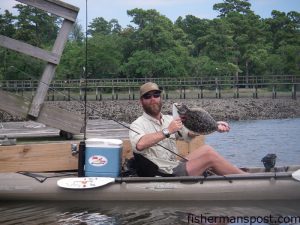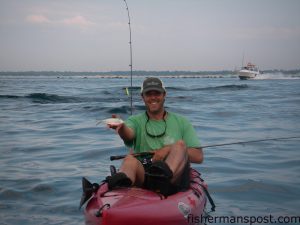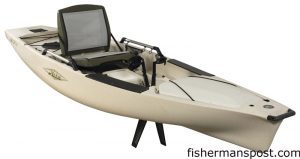Pedal With A Pro

Michael Garet, of Hobie Kayaks, with a keeper flounder he hooked on a Gulp bait in Hewlett's Creek while fishing out of his Mirage Revolution.
Riding the tide, swimmers paddled and kicked their way past us as Gary Hurley (Fisherman’s Post), Will Huffine (Great Outdoor Provision Company in Wilmington), Hobie Kayak Rep Michael Garet and I turned our bows south after launching from the soundside of Wrightsville Beach into Banks Channel.
On most of my kayak adventures, I try to plan my trip to head the way of the swimmers, paddling with the tide one direction to my destination and, after the tide change, enjoying the tail current on the way back, too.
This, however, was no ordinary paddle. In fact, it’s far more accurate to call it a pedal, as the boats we were in are propelled by Hobie’s patented Mirage Drive pedal system instead of a double bladed paddle. Mine wasn’t even technically a kayak; as Michael told me, Hobie has labeled it a Pedal-Powered Fishing Platform.
I had my butt parked comfortably in the seat of one of Hobie’s newest creations and their latest Mirage-Driven PPFP, the Mirage Pro Angler.
At nearly 14’ long and 38” wide, the Pro Angler has dimensions closer to a small jon boat than a kayak, and the width gives it far more stability and carrying capacity than even the largest fishing kayaks. I’d pored over every curve and feature of the Pro Angler at Great Outdoor’s Wilmington location and thought the craft looked incredible, but at 6’8” I wasn’t sure I’d fit in it.
My doubt was bolstered by the fact that when I was searching for a fishing kayak last year, my choices were restricted to just a tiny fraction to of the models on the market—not even the majority of the longer, wider kayaks marketed for the big guys would allow me to extend my legs and settle down comfortably.
The second time Will saw me eyeing up the Pro Angler at the front of Great Outdoor’s kayak section, he had some good news. He’d told Michael of my concerns, and the company rep was nearly certain the boat would accommodate me.

Gary Hurley with a threadfin herring he snagged with a Gotcha plug while jigging at the Masonboro jetties out of a Hobie Mirage Revolution.
So, by virtue of size, I got to hop in the only Pro Angler Will and Michael had brought along, with Gary and our hosts each pedaling a Hobie Mirage Revolution, a narrower Mirage Drive kayak that Will and Michael enjoy because it paddles and maneuvers as well as a typical top-line fishing kayak through narrow spots in streams and creeks, and the narrower hull can muster a bit more speed than the Pro Angler.
The Pro Angler is no slouch in the speed department, however. Mine was equipped with Hobie’s Turbo fins, giving me plenty of zip to keep up with the pack.
The Mirage Drive features a pair of pedals that go back and forth, instead of rotating, supplying power via chain-drive to a pair of underwater fins that the company compares to penguin wings. (the fins flap back and forth beneath the hull to propel the boat forward). As we made the turn into Masonboro Inlet against a stiff incoming tide, they gave me substantially more power and (once I’d gotten the hang of the rudder lever beside my left leg) manueverabilty than I’d have had were I flailing against the flow with my paddle.
Our plan was to go chase some spanish mackerel just outside the jetties, and I followed Will as I watched Michael and Gary ease out towards the inlet mouth.
“Let’s just go over the wall,” he said, turning up the beach. The incoming water had the block wall leading to the rock jetty buried beneath the surface, but I was still a bit apprehensive about crossing an underwater obstacle I wouldn’t even consider in a boat.
Fortunately, the Mirage fins cleared it with ease, and as Gary and Michael followed our lead, the four of us began pedaling up the outside of Masonboro’s north jetty, pausing to cast occasionally.
Aside from the extra speed of the Mirage Drive, its great advantage over a traditional paddle-fishing kayak became immediately apparent—you can cast and cover water, totally in control over the boat, at the same time. It’s like getting an electric trolling motor.
We made our way up the jetty, casting Gotcha plugs and Maria jigs, and with Will trolling a Yo-Zuri Deep Diver; however, we but didn’t find much worth our attention until we rounded the jetty’s tip.
In the mouth of the inlet, the small terns that feed on the same little baits the spanish like were working some bait furiously, but the mackerel seemed to have moved on. We casted and trolled a variety of lures, but neither our crew nor the boats around us were scoring any hookups.

Hobie 1

Hobie 2
I felt a thump at one point, but the light thrashing telegraphed through my rod tip soon turned out to be a threadfin herring snagged on my Gotcha.
Will quickly pedaled over and offered me a wire live bait rig, which I impaled the threadfin on after tying it to a baitcaster I set in one of the Pro Angler’s vertical rod holders.
Despite our best efforts, the spanish just weren’t to be found that morning, but Gary and I soon commenced to amuse ourselves by jigging up small sea bass, bluefish, and assorted bottom dwellers from the rocks below. I also managed to donate a number of jigs to the structure.
A number of large boats, including a 100+ footer that made the 26’ center console she was towing look like a dinghy, passed the inlet while we were working the birds and the rocks, and the kayaks proved their stability against their wakes colliding with the swells rolling in from the sea.
With newspaper work to do in the afternoon, Gary and I had to head for our launch point just before lunchtime. The tide had turned while we were fishing, and again we pedaled upcurrent with ease, Mirage fins flapping away. I can only imagine what the boats would do with the current or in still water—the pedal drive system has a clear speed advantage over paddling.
Stopping to stretch our legs on the south end for a moment, another advantage of the Mirage Drive became apparent. Pushing either foot pedal all the way forward locks the Mirage fins up against the hull, allowing the boats to be beached with ease, and a short pull on the rudder cord locks the rudder up as well.
I hated to end the day so early as Gary and I climbed into the car. Making it even worse, Michael and Will were planning where they’d be fishing after eating lunch.
They settled on Hewlett’s Creek, and, as I learned later by phone, they found some flounder and red drum. They produced by fan casting Gulp and Slurp baits while pedaling the kayaks along the south side of the creek headed in and the north side headed out.
The Hobie Mirage Series boats definitely represent an improvement in kayak technology, particularly for the angler, as the advantages of extra speed and hands-free maneuverability simplify the act of fishing from kayak (or PPFP) greatly. The challenges one must overcome to paddle-fish aren’t great, but they may well keep some anglers from enjoying the sport, which is a shame. The Mirage Drive boats solve that problem, and they are ideal for people trying to transition into the sport.
The Pro Angler in particular features some advancements well beyond what’s previously been considered possible for a fishing ‘yak. The boat is stable enough to stand up and walk around on and features built-in storage for six horizontal and two vertical rods. It also has built in Plano tackle box storage, hatch and tankwell storage for just about anything an angler could want (including fish), cooler and livewell options, and accessory mounting rails to mount a variety of optional accessories (including fish finders, GPS units, downriggers, lights, and more).
Interested anglers can check out the Pro Angler and the rest of Hobie’s Mirage Drive boats at Wilmington’s Great Outdoor Provision Company or learn more about their full line of products at www.hobiecat.com.
